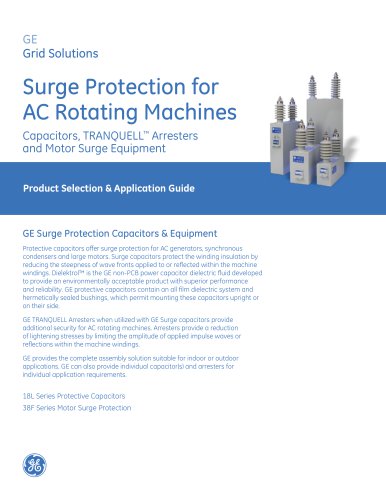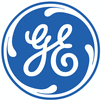
Catalog excerpts
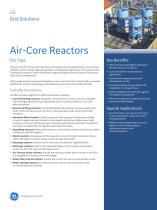
Air-Core Reactors Dry Type GE has more than 50 years of experience in designing and manufacturing air-core reactors (ACR) for various market segments globally, including power generation, Transmission and Distribution networks, industrial facilities, Original Equipment Manufacturers (OEMs) and electrical test laboratories. ACR provide a linear response of impedance versus current which is essential for numerous applications. The dry type design is maintenance free and environmentally-friendly. Cost-effective Solutions GE offers a broad range of cost-effective solutions including: • Current-limiting reactors: designed to limit the fault currents to levels compatible with existing protection/control equipment and as a result provide for a very cost-effective solution • Neutral-earthing reactors: Connected between the neutral of a power system and earth to limit the line-to-earth current to a desired value under system earth fault conditions • Harmonic filter reactors: Usually connected with capacitors and resistors in filter circuits to reduce harmonic content in the network which cause higher losses, high neutral currents and interference with computers and telecommunications equipment and which are responsible for high harmonic distortion levels • Smoothing reactors: Reduce the harmonic currents and transient overcurrents (ripple) in Direct Current (DC) systems • Shunt reactors: Compensate for the capacitive currents of long transmission lines or cables, allowing more active energy to pass through the system • Damping reactors: Limit the inrush and outrush currents of capacitor banks • Discharge reactors: Used in the bypass/discharge circuit in series compensation systems to limit the capacitor discharge current • Arc-furnace series reactors: Provide the necessary power factor correction and limit the unstable arc-furnace current and voltage • Power flow control reactors: Control the current into two or more parallel circuits • Motor starting reactors: Connected in series with a motor to limit the inrush current during motor starting Key Benefits • High mechanical strength to withstand elevated short-circuit forces • Low noise level for noise sensitive applications • Conservative temperature rise for extended service life • Customized space saving solutions for installations in compact areas • Surface treatment for protection against UV radiation and pollution • Minimum maintenance requirements and environmentally-friendly Special Applications • Test lab reactors are special ACRs used in test laboratories, mainly for current-limiting purposes • Additional special applications include duplex current-limiting reactors, split-phase shunt or zero tolerance eeactors
Open the catalog to page 1
Air Core Reactors Dry Type Inducing Energy with Success Air Core Reactor Applications 1.1. Current Limiting This reactor is series connected to the transmission line or to the feeder to limit the current under system fault conditions to levels compatible with the protection equipment of the circuit. It is a very cost-effective solution, eliminating the need to upgrade the entire switching and protection system when the short-circuit power of the system is increased. This reactor is designed to provide specified impedance and to withstand the rated and fault (short-time) currents during a...
Open the catalog to page 2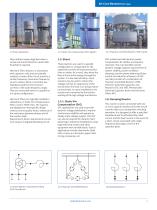
Air Core Reactors Dry Type 1.5.1 Static Var Compensation (SVC) System 1.5.1 Thyristor Controlled Reactors (TCR) reactor Most utilities impose high fees when a certain Harmonic Distortion Level (HDL) threshold is reached. SVC systems provide dynamic power compensation for utilities and industry networks. The main benefits include: dynamic voltage support, improvement of system stability, power oscillation damping, reactive power balancing, flicker control and reduction of losses. An SVC normally consists of a combination of: Thyristor-Controlled Reactors (TCR), Thyristor-Switched Capacitors...
Open the catalog to page 3
Air Core Reactors Dry Type 1.7. Discharge Reactor This application includes reactors for series compensation systems which use capacitor banks which are series connected to the transmission lines. Discharge reactors: improve voltage regulation improve system transient stability increase transmission line capacity reduce electrical losses and save on costs. 1.8. Arc-Furnace Series Reactors The arc-furnace series reactor is connected in series with the electrodes of an arc-furnace used to smelt metals (iron, steel, aluminum, etc.). It provides the necessary power factor correction and limits...
Open the catalog to page 4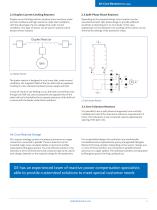
Air Core Reactors Dry Type 2.2 Duplex Current-Limiting Reactors 2.3 Split-Phase Shunt Reactors Duplex current-limiting reactors produce a low reactance under normal conditions and high reactance under fault conditions, with the advantage of a low voltage drop under normal conditions. This type of reactor can be used in systems which always remain isolated. Depending on the required ratings, shunt reactors can be manufactured with split-phase design to provide sufficient sensitivity in detecting turn-to-turn faults. In this case, unbalanced currents between two windings of the reactor can be...
Open the catalog to page 5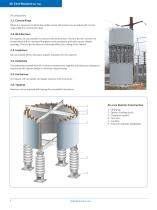
Air Core Reactors Dry Type Accessories 3.1. Corona Rings When it is necessary to eliminate visible corona, GE reactors are provided with corona rings made from aluminum tubes. 3.2. Bird Barriers On request, GE can provide the reactors with bird barriers. The bird barriers consist of a temperature and UV resistant fiberglass reinforced plastic grid with square-shaped openings. The bird barrier does not adversely affect the cooling of the reactor. 3.3. Insulators GE can provide all the necessary support insulators for the reactors. 3.4. Pedestals The pedestals provided with GE's reactors...
Open the catalog to page 6
Air Core Reactors Dry Type 5. Terminal Orientation and Hole Patterns Cost-effective solutions Installation 4.1. Location GE's reactors are suitable for either indoor or outdoor installation. Reactors are often installed in existing substations or installed to replace existing reactors. The reactors are designed to fit within space limitations or to be mounted directly onto the existing foundations. They are also designed for use inside enclosures. In this case, the reactors are designed to avoid excessive heating. GE's reactors are supplied with NEMA or IEC flat pad aluminum or copper...
Open the catalog to page 7All GE Grid Solutions catalogs and technical brochures
-
Static Var Compensator Solutions
12 Pages
-
Kelman TRANSFIX
2 Pages
-
Kelman MINITRANS
2 Pages
-
MIG
3 Pages
-
DTR
4 Pages
-
SPM
8 Pages
-
TOV
3 Pages
-
MDS SD Series
4 Pages
-
MIC
2 Pages
-
Multilin F60
9 Pages
-
Model PT7-1-150 & PT7-1-200
2 Pages
-
Models PT7-2-150 & PT7-2-200
2 Pages
-
Model PT6-2-125
2 Pages
-
Model PT6-1-125
2 Pages
-
Models PTW5-1-110&PTW5-2-110
2 Pages
-
Models PTG4-1-75 & PTG4-2-75
2 Pages
-
Models PTW3-1-60 & PTW3-2-60
2 Pages
-
Models PTG3-1-60 & PTG3-2-60
2 Pages
-
Models PT3-1-45 & PT3-2-45
2 Pages
-
Model 3PT3-60
2 Pages
-
MIG II
8 Pages
-
Model JVW-110C
2 Pages
-
Model JVW-5AC-1
2 Pages
-
Model JVW-5C
2 Pages
-
Multilin T60
9 Pages
-
Multilin 489
9 Pages
-
Multilin™ D25
8 Pages
-
Multilin D485
1 Pages
-
Multilin P485
1 Pages
-
MultiNet
3 Pages
-
iNET-II
4 Pages
-
MDS™ iNET 300
2 Pages
-
MDS iNET 900®
2 Pages
-
Multilin™ PQM II
8 Pages
-
Multilin L90
10 Pages
-
COSI
2 Pages
-
Reason DR60
4 Pages
-
Multilin 850
4 Pages
-
G650
8 Pages
-
Hydran M2
2 Pages
-
MultiLink ML3000 Series
12 Pages
-
TN1U
4 Pages
-
JungleMUX SONET Multiplexer
4 Pages
-
Multilin™ MM200
8 Pages
-
Multilin™ MM300
8 Pages
-
Multilin 339
16 Pages
-
Multilin 469
10 Pages
-
Multilin A60
6 Pages
-
Multilin 350
16 Pages
-
Multilin F650
12 Pages
-
Multilin 750/760
10 Pages
-
F35
8 Pages
-
345
12 Pages
-
745
8 Pages
-
Multilin G30
9 Pages
-
Transmission Overview
9 Pages
-
Multilin HardFiber System
14 Pages
-
Multilin UR & URPlus
18 Pages
-
Multilin C30
6 Pages
-
Voltage Regulators
16 Pages
-
g3 Technology
2 Pages
-
Rectifier
4 Pages
-
RMIO
2 Pages
-
MiCOM Agile P54A/B
2 Pages
-
MultiSync™ 100
6 Pages
-
Multilin G60
9 Pages
-
Multilin D400
12 Pages
-
GL 107X
2 Pages
-
Disconnectors
12 Pages
-
CGVB-05
2 Pages
-
KOTEF
4 Pages
-
Adjustable Height Sub Base
2 Pages
-
HV Transmission Solutions
8 Pages
-
FK
4 Pages
-
B65
4 Pages
-
Safe-NET Network Transformer
8 Pages
-
Green Power Transformers
4 Pages
-
COSI-RogoFlex
2 Pages
-
Grid-GA-L3-COSI_CEVT
2 Pages
-
P50 Agile P154 / P253
4 Pages
-
MiCOM Agile P24x
8 Pages
-
239 Motor Protection
8 Pages
-
Power Transformers
8 Pages
-
smorb
3 Pages
-
MIF II
8 Pages
-
SR family
2 Pages
-
735/737
4 Pages
-
hid
2 Pages
-
dtp
5 Pages
-
IEC Oil Filled & SF
12 Pages
-
Gas Insulated Switchgear
24 Pages
-
Multilin UR & UR Plus
18 Pages
-
M60
8 Pages
-
MDS Orbit Platform Brochure
12 Pages


































































